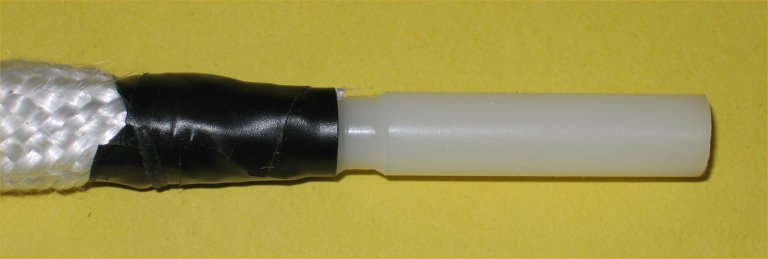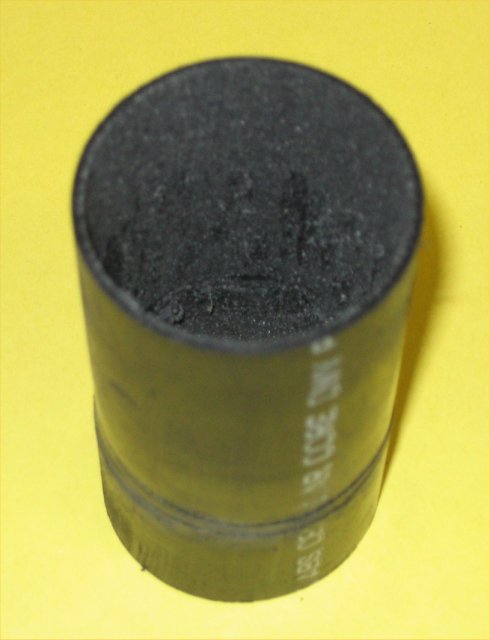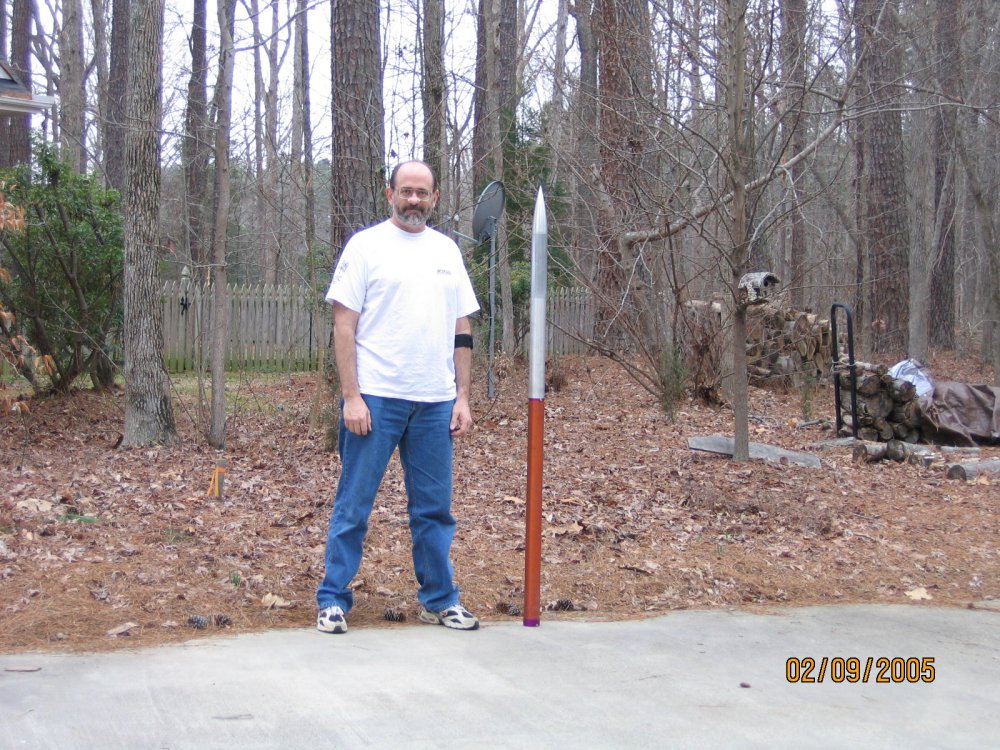RATTWorks TriBrid Experimental Hybrid
Rocket Motor
This motor is an ABS + Alcohol + N2O fueled rocket motor. Is it a
Hybrid? Is it a Liquid Motor? It's essentially an Alcohol rocket motor
with an initial thrust producing ABS + N2O phase that provides a soft
start for the Alcohol Phase.
This Tri-Fuel configuration {ABS; ABS + ALCOHOL; ALCOHOL} provides a
stepped thrust curve.

The OD of the tubing is 0.375 with 0.250" ID. It's "stock 64mm
RATT fill tubing".
The OD of the milled groove is 0.315 to 0.325" . This seems standard
for his motors.
In the re-worked Tribrid, (i.e. LR-5 to current Tribrid Spec) the flat
part of the
milled
groove is about 0.14" (in one reload) a
In the original LR5 Reload The flat past of the milled groove is about
nd 0.043 long (in the original
LR-5 reload).
A key measurement is that from the end of
the tubing, to the first flat part of the groove (intending where the
burn through occurs) is 1.5"

The grain is 3.5" long ABS drain pipe. It's been milled to 0.075" wall
thickness (measured) or ID of 1.80"
I'll further note that SCH 40 PVC has an ID of 1.60" and thinwall PVC
has an ID of 1.75" . Dave says that either SCH 40 or thinwall tubing is
fine. He prefers the thin milled ABS because you get to the alcohol
only phase more quickly. (The ABS hybrid starting mode is just a soft
start mechanism for an alcohol motor - so might as well get to the
alcohol as quickly as possible.
Dave recently took my Tribrid and re-worked the injector to change the
O/F ratio from 3:1 to 6:1 based on his current research.
The motor, btw, is from a RATT LR-5 Bi-Propellant rocket that from the
late 90's. Dave re-worked the innards to current TriBrid specs.
Supposedly this minimum diameter aluminum beauty will fly to 16K ft. I
just realized I didn't have the aluminum fin-can assembly on for this
picture. sheesh.

I will make some nozzle and geometry notes here.
Nozzle. The Nozzle ID is a "shim measured" 0.680" . I haven't mapped
that back to any drill size. This is for the K-240 TriBrid.
Injector Arrangement
The
injector for Nitrous is 3/8" tubing with an ID of 0.250" - but it
is coaxial with the alcohol injector which has an OD of 1/8" And the
brass N2O fitting has an inner sleeve further reducing the injector
cross sectional area.
Nitrous Injector
The
injector for Nitrous is 3/8" tubing with an ID of 0.250" - but it
is coaxial with the alcohol injector which has an OD of 1/8" which
leaves an injector surface area of <to be computed>
The fitting is a brass 1/4" tubing fitting with internal slip shoulder.
Based on an encumbered micrometer reading (the Alcohol Injector was
installed), the measurements may be 0.195" (mic inside), or 0.247 - 2 *
(0.028 wall thickness). as the effective ID of the injector
fitting.
The actual area would be that minus the area of the 1/8" OD Alcohol
Injector tubing.
Alcohol Injector
The tubing is 1/8" OD thinwall nylon tubing. It accepts a 3/32" drill
inside and it's ID is (?) IThis is Nylon 6 Type H (Hard) McMaster 8359K11.
It is a thinner wall tubing than the high
pressure Type H tubing used for 1/8" U/C RATT and PP motors which
accept a 3/32" drill bit snugly.
This tubing is 4 1/4" long, and when installed is 2 5/8" from
end of brass N2O injector fitting to end of tubing. The brass plug in
the end, compressed by the olive, is 3/32 or 0.093" brass rod
(for which
3/32" drill was a tad loose).
Note that this tubing is thinner wall than the type H 1/8" tubing used
for RATT U/C valves and as such would have higher CD. So using the U/C
thicker type H tubing would result in a richer O/F ratio by delivering
less Alcohol.
Actually, the top of the overall Injector Assembly has a brass plug
with a hole drilled through. This is the limiting factor in Alcohol
delivery - not the nylon tubing stub. This hole takes a 1/16" drill bit
- albeit a little loosely. A 5/64" bit is too big. So the size is
somewhere inbetween.
Injector Assembly
O-Rings
The alcohol piston and the alcohol tank fitting take #020 o-rings (two
each). The Injector housing to tank takes two #137 o-rings. The
Injector housing to phenolic linker portion takes two #224 o-rings.
Misc
As a side note, for "regular" K-240 the nozzle is 0.600" and the
injector is 5/16" tubing with and ID of <to be measured>.
The TriBrid Assembly Manual is here.
RATT L/M Fuel Grains (Placeholder)
Phenolic sleeve on each end. Appears to be stock phenolic tube or
hollow rod. 2.5" long 1.935 ID, .193 wall thickness; 2.325 OD.
There are at two types of sleeves - one chamfered on one end and an
other chamfered on both ends. The chamfer is to seat o-ring.
(assembled, o-ring is still
nealry completely visible). The sleeve that is chamfered on both ends
goes towards the injector.
O-ring to match 0.135 thick, 200 series (same thickness as my 237,
238); smaller than my 137s. Dash-???
The Grains for both are White translucent poly of some sort.
The L grain ID is 1.450"; The M grain is 1.30. The M grain is noticably
roughened a lot inside; not so for the L grain (which shows signs of
internal clamping fixture but not roughening).
The Shoulder OD is 1.935 (matches phenolic ID
exactly; snug fit) and is 0.500" long. The Grain OD is 2.330 and
is machine turned to OD (evidence of internal clamping fixture of some
sort to support it).
The L grain pipe is 10.750 Long (including shoulders) and the M grain
pipe is 13.750" long (including shoulders).
The assembled OAL of the L is nominal 15" and the M is nominal 18"
The injector tubes are the same usual RATT fill tubing. 16 3/8, 19 3/4"
long; The milled groove is 1.600 through 1.900 including the
cutting tool bevel from the top end of the tube. The xx tube is turned
to a 0.032 OD. (Tube is .0380 OD (I think nominal 0.375 3/8" tube); ID
is 0.250 (So 1/16" walls)


